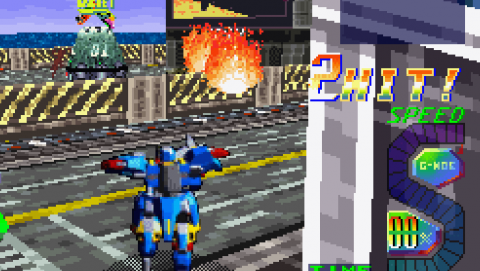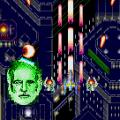The Sega Saturn has always, in the eyes of developers and consumers, had a bad reputation for 3D. Its 2D prowess is championed, but generally the system is seen as technically inadequate when compared to its rival of the era, Sony’s PlayStation. While broadly speaking this is sort of true – in as much as the finest 3D game on the Saturn can’t compete with the finest equivalent on the PlayStation – there are several Saturn titles which showcase just how powerful the system could be, when handled correctly and with beautiful art direction backing it up. Bulk Slash is not only incredibly fun, but it deserves to stand alongside the Panzer Dragoon series, Radiant Silvergun and Burning Rangers, as the pinnacle of what the system was capable of. The developer is Computer Artist Production (AKA CAProduction), a company based in Nagasaki with strong links to the Hudson of old, and responsible for various popular games including Lords of Thunder, Hagane and Ginga Fukei Densetsu Sapphire.
Described loosely: Bulk Slash is like a cross between Virtual On and Burning Rangers, with simple controls and an instantaneous mecha-transformation mechanic. It’s much simpler than either of those two though, playing more like a traditional arcade action title. There’s barely even a story… After the great galactic war ends, the planet Blau and its citizens are oppressed and discriminated against by the victors. Former military chief Alois Gardona enacts a coup d’état, to bring Blau back to power, and so a coalition of planets is rallied to put a stop to them. No prizes for guessing which real-world early 20th century events this seems to be copying… As the game’s protagonist you are an S.D.F. pilot who must single-handedly win the war.
You can switch between controlling a walking robot or jetfighter at will, as many times as you like. As the robot you can jump and shoot, and when close to an enemy you can attack with a laser sword. When not attacking a little bar charges up and, when nearly full, allows you to lob a powerful bomb with wide blast radius. There are also three varieties of power-up with finite ammo: Flame Blaster, which is like a devastating flamethrower; Bezier Blaster, a kind of homing laser; and Napalm Blaster, which shoots out little energy spheres and isn’t particularly useful. You run, turn and strafe via a combination of the d-pad and L&R buttons (customizable in the Options menu), while A transforms you, B shoots and C jumps while in ground mode. As the jetfighter you have unlimited flight, a standard blaster attack and, if you allow the bar to charge up, a series of homing missiles. During flight mode button C changes speed between 25, 50, 75 and 100%.
It’s not a complicated system – certainly it’s nothing like Virtual On, or any of the Armored Core games by From Software. Rather, Bulk Slash isn’t so much a mecha game, rather an action game that happens to have mecha in it.. Adding some needed depth is the Manageable Intelligent Support System (aka M.I.S.S.), which is a fancy way of describing your navigators. There are seven in total, one for each planet in the game, and it adds a kind of pseudo dating-sim element to proceedings. If you can find their icon in the playfield, a little pink helmet with M.I.S.S. above it, you can choose to bring that navigator along for the ride. She’ll scream out when you take damage or grab power-ups, and will describe where your next goal is in relation to your current position. In this way it feels a lot like Burning Rangers, with an audio instruction telling you where to go. According to an online guide, each navigator provides some kind of ability bonus. Having tested six of the seven however, none of them seemed to do anything special. They level up through usage though, so it’s possible their attributes only become noticeable at higher levels.
This is where the so-called “dating-sim” aspect comes in. Each girl gains experience through usage, which affects their ending and the bonus art unlocked after the game’s completion. The idea is that you’ll play through the game repeatedly with your favorite navigator, raising her affinity for you to the maximum Level 3, unlocking all the artwork, and enjoying the bonus ending after the regular one. For navigators who can only be recruited in later levels, such as Karen Steiner, you need to finish the game with them and then restart to build up sufficient experience. Since the game is quite short, this is how it encourages replayability, repeatedly grinding with each navigator. Also the seventh navigator, Kina, is only accessible after finishing the game with each of the previous six. According to a guide, Kina grants you infinite ammo for sub-weapons, though unlocking her seems more effort than it’s worth.
Characters
Cress Dawley / クレス・ドーリー
Age: 19
Job: S.D.F. Pilot
Protagonist of the story, silent until just before the final boss, and childhood friend of Reeza. You see him as a young boy in the intro cinema, promising to protect her.
Reezen Ravia / リーゼン・ラヴィア
Age: 19
Job: Final Boss
Childhood friend of Chris, and the game’s main antagonist. After the galactic war ended her father was executed as a war criminal. She joins the military group led by Alois Gardona to fight the discrimination of her people on the planet Blau.
Leone Rhodes / レオネ・ローデス
Age: 16
Job: S.D.F. Soldier
The first navigator, found in Stage 1 (Grün), right in front of you. Heiress of an elite military family. Has a strong desire to get married.
Lila Hart / リラ・ハート
Age: 18
Job: Idol Singer
Found in Stage 2 (Gold), north-east of the map, inside the arena. This popular cosmic mega-idol is probably the most annoying navigator in the game.
Metical Flair / メティカル・フレアー
Age: 16
Job: Princess
Found in Stage 3 (Braune), directly to the left of your position, just behind the castle but still within its outer walls. Aloof first child of the planet’s royal family.
Naira Savage / ナイラ・サベージ
Age: 22
Job: S.D.F. Officer
Found in Stage 4 (Schwarz), north-east of your position, beyond the bomb target cubes, aboard a giant freighter. Higher ranking than Chris, enjoys long baths.
Rupiah Rood / ルピア・ルード
Age: 20
Job: Thief
On floor four of Stage 5 (Rot), on one of the high beams as you leave the elevator. Change into the plane to reach her. Comes from a long line of thieves.
Koron Steiner / コロン・スタイナー
Age: 19
Job: S.D.F. Sergeant
According to the mini-map (press XYZ), she’s located in the south-western part of stage 6, underneath a giant tree in the middle of a frozen lake. Bilingual and prone to saying “OH MY GOD!” in the most salacious Engrish you’ve ever heard.
Kina Dibiase / キナ・デビアス
Age: ?
Job: ?
Only accessible after finishing the game with each of the previous six navigators. Once you’ve done this you’ll find her through the previously locked door in the starting room of Stage 7. According to online guides, having Kina as a navigator gives you unlimited Flame ammo.
There are seven stages, each containing a goal or series of goals, such as enemies to destroy, an ally to protect, or keycards to collect, culminating with an enormous boss battle usually over the entire playfield. There’s an impressive range of diversity to the seven planets too. The first couple are set in the city, during the day and then at night, and involve blowing a set of predefined targets before the boss. The third stage is during a sunset, where you need to protect a spaceship as it takes off, with a medieval castle as part of the playfield, and a little train which travels around the outskirts, carrying hostile cannons. Escort missions are usually the worst in any kind of game, but this is surprisingly decent. The ship already has two robotic escorts which provide a lot of protection, meaning you just need to mop up the outlying waves, and there’s plenty of time to explore the stage as well, which is easy in flight mode. You have to be really lax to fail this mission.
The fourth stage switches to an open area of outer space, with you needing to carry four explosives to predefined target areas, while avoiding enemies and space mines. You can walk around on some asteroids and enemy ships, but flight mode is almost mandatory here; imagine a free-roaming Star Fox level in space. The fifth planet sees you go underground, navigating a military complex, collecting keycards and riding elevators. The sixth planet returns to the style of the first two, set in an open, outdoor area with predefined targets. Everything is covered in snow, and the targets are enormous walking robots, giving it a slight Empire Strikes Back feeling. The final stage is another underground maze with four bosses on the trot.
The cool thing about the stage set-up is that it’s only semi-linear. You can complete planets 1-3 in any order, which unlocks planets 4-6, and then afterwards the final planet is unlocked. Considering that the game doesn’t save at any point between missions, thereby forcing you to complete the game in a single sitting, this slight freedom is welcome. Each mission has a limit of 10 minutes, but can be done in much less. You’re looking at a single playthrough of around 45 minutes, not counting restarting after dying. It’s quite an easy game overall, apart from the last level where you’ll probably use up all your continues trying to beat the last four bosses in a row. If it weren’t for saving the experience level of each navigator, there wouldn’t be any need for save data, since it plays like a fast-paced action title. It’s bright and colorful, with a focus on quick reflexes and explosions, akin to something by Treasure, like a mecha-themed Gunstar Heroes in 3D. Almost.
The visuals deserve even more praise, because in motion they’re quite something. The colours are so explosively bright you’re left with the feeling the game is bleeding liquid neon into your eyes; a gorgeous multihued cosmic salad of luminescent polygons which is utterly hypnotic to behold. It might not be as technically impressive as Omega Boost on the PlayStation, which is another excellent mecha title, but it’s vastly more impressive than games like Amok or Independence Day on the Saturn. The music is also upbeat, and every boss is introduced via a short newsreel style cinema, making for a slick overall presentation.
The neon art-style is perfect though, and the low-resolution textures on the polygon models actually add some charm. It would be amazing if the game were revisited on more powerful hardware, perhaps using cel-shading to maintain the brightness of the original, while correcting the draw distance problems. As for pacing and progression, that could be fixed by permanently unlocking stages after completion, and toning down some of the grinding needed for navigators. The game works well because it’s short and exciting to play, and the arbitrary addition of “gotta unlock them all” is tedious if you take it seriously. Sometimes you just want to spend a few minutes on the sixth planet without having to get there first.
In fact the only real flaws with Bulk Slash are an annoying sense of progression and a poor draw distance. It can be significant in places, and in several instances will trip you up. Notably in Stage 4, where you’re required to carry explosives to specific targets, enemies tend to “pop in” suddenly and are unfairly difficult to avoid. You can’t see the target until you’re right on top of it, forcing you to rely on your radar and navigator. These work well, but what appears to completely empty space suddenly turns into a mine field, resulting in damage and a loss of the bomb you were carrying. The problem gets worse if you fly high up, resulting in the entire map being visible, but none of the scenery. Bosses can also be problematic, with their shapes only visible when up close, by which time it’s difficult to target specific areas. The homing missiles in flight mode make up for this, but it’s still annoying.
In spite of these issues, the controls are tight, the visual sublime, and the action simple, diverse and relentlessly fun. It’s demonstrably one of the best games in the Saturn’s library.


